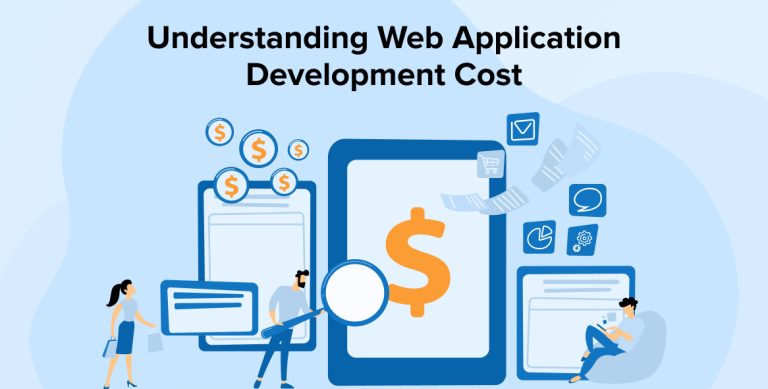
Nowadays having a strong internet presence is a fundamental step to the success of any business. A well-designed web app may attract new customers, uphold industry standards, and highlight your business services. To ensure their online presence is trustworthy and influential, businesses should strategically prepare before beginning web application development. However, the initial factor that needs consideration is the cost of developing a web application.
Therefore, to understand the overall cost, here’s a detailed blog article outlining the breakdown of web application development costs based on different kinds of projects. But before we dive deep to understand the cost of developing web applications, let’s understand the factors that influence cost.
1. Factors Influencing Web Application Development Costs
Web application development costs vary due to the influence of various factors like the app’s complexity, the developers’ location, and various tech stacks. Let’s understand each factor in detail.
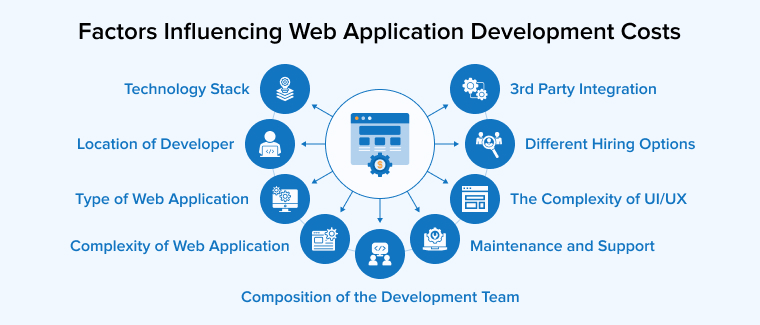
1.1 Type of Web Application
Web application development costs might change based on the project’s specifics and type of web application. Here are some typical examples:
1.1.1. Multi-Page Applications (MPA)
Multi-Page Applications (MPA) consist of more than one page. Businesses in education, healthcare, and e-commerce can greatly benefit from this format. MPAs work effectively for information-heavy websites like blogs and discussion boards. Multi-page apps that have gained widespread notoriety include:
- AliExpress
- eBay
- Amazon
1.1.2. Single-Page Apps
Single-page applications (SPAs) consist of only one page, you can include all the necessary details there. In addition, the page does not reload after button clicks, thus page load wait times are decreased. Therefore, if you require a quick-loading website, a single-page app is your best bet. Examples of SPAs are:
- Google Calendar
- Gmail
- Google Drive
1.1.3. Progressive Web Apps (PWAs)
PWAs are hybrid apps that use web technologies to create an experience similar to that of a native app. They can access the device’s storage space, operate offline, send push alerts, and more. Progressive applications represent the future of mobile technology. Here are a few examples of PWAs:
- Starbucks
- Spotify
We develop apps to meet a diverse range of company needs, and the web application development cost can vary accordingly.
1.2 The Complexity of UI/UX
The complexity of UI/UX is also considered to be an important factor while discussing the cost. Total cost of web application development can vary with the design preferences. Let’s understand the different factors that falls under it.
1.2.1. The Scope of Design
An accurate quote from a skilled UI designer will encompass all of the essential tasks. Some factors to think about are how complicated the design is, how many testing rounds will be required before the product is released to the public, and how well the finished product works.
User interface design tasks that might cause a project’s scope to grow include:
- Design Analysis
For how many years has this brand handbook been in your possession? To identify the problems that the design must solve, is it necessary to engage in design thinking or brainstorm?
- Market Research
Have you done research into your target audience’s interests and requirements and developed consumer ideas? What tools are required to create storyboards, wireframes, and prototypes? Would storyboards and wireframes for user experience (UX) be necessary for you? Is it essential to have a complete set of interactive prototypes? How will the UI designer collaborate with other artists on a project?
- Interactive Elements
What motions, animations, or other components will be necessary for the design? How intricate will your site’s structure, menus, calls to action, alerts, and reminders be?
Any web development company that wants to give an accurate quote needs a detailed description of the task to be done.
1.2.2. User Testing Requirements
Testing is generally necessary for a successful UI design since it should accurately reflect the end-user’s needs. The variety of displays, interactions, and options available to a user inside your UI will determine how much time you will need to spend testing.
Customer feedback and ideas gained from such testing can be helpful. To guarantee that users’ interactions go as planned, certain projects may need to undergo many rounds of testing, both automatically and manually. The project’s cost could be influenced by the wide range of consumers you’re aiming for. This is why creating personalities and storyboards from the outset can be so useful.
A professional user interface designer will have refined ways of gathering information as promptly and effectively as possible, which can save costs for your project.
1.2.3. The Complexity of Information Architecture
Simplicity is of paramount importance in user interface design. Complexity, however, is inevitable for highly interactive and information-dense websites and mobile applications. UI designers need more time, effort, and testing to guarantee that the architecture faithfully represents the data while still being easily navigable amidst complexity.
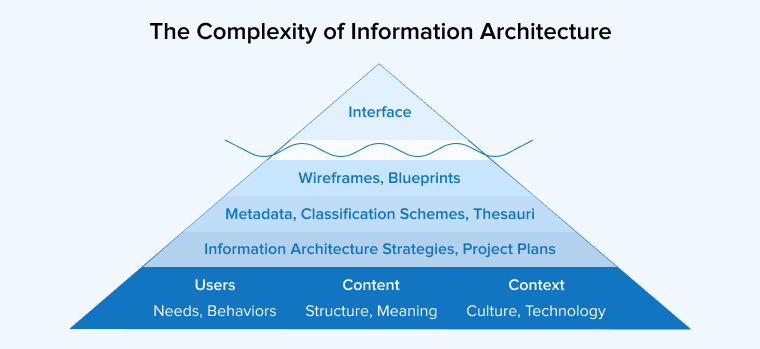
When there are many people involved with diverse ideas regarding which data, pages, or screens should be prioritized, a lively debate over the information architecture is to be expected. Over-design can be avoided by defining and evaluating these variables early in the process. However, doing so often results in higher costs for a UI designer.
1.2.4. The Designer’s Experience and Rate
The following information refers to the approximate billing rates imposed by intermediate-level experts in the United States.
| Type of Designs | Hourly Fees |
|---|---|
| Visual/ UI Design | $20-$40 |
| Interaction Design | $30-$60 |
1.3 Complexity of Web Application
Unique content management systems (CMS) and well-planned designs significantly contribute to the complexity of custom applications.
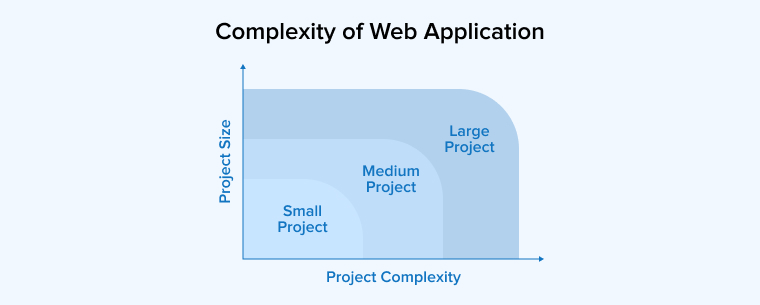
For a company considering updating its CRM software, the development task could take up to six months to complete.
It might cost anything from $60,000 to $250,000 or more to create a web app. Web applications of all stripes have a core functionality.
We can quickly summarize the expense of building a web app by its features as follows:
| Complexity | Description | Functionality | Cost |
|---|---|---|---|
| Basic | Basic in design and functionality, its primary purpose is to communicate data on your product and facilitate user engagement. |
|
$9000 to $15000 |
| Medium | These apps have more complicated user interactions and might have a significantly higher page count. |
|
$20000 to $50000 |
| Complex | Products that have recently been updated in terms of architecture, material, or user management systems, as well as products that may be constructed around user accounts to automate company operations can be included here. |
|
$50000+ |
1.4 Technology Stack
Time and money spent on creating a web application are proportional to the technologies used in the development process. The total web application development cost might be affected by the complexity and number of developers needed to implement various computer languages, platforms, and third-party tools.
Finding the right technology stack involves balancing various factors such as budget, timeline, capacity, and the web project’s intended features. Working with a skilled development team that can advise you on the best technologies to use for your needs and budget is essential.
Using their knowledge, development can be optimized, compliance between components can be guaranteed, execution can be maximized, and costs can be kept to a minimum.
1.5 Location of Developer
The hourly prices of development vary on the physical location of the programmers or outsourcing organizations. Many companies often choose to outsource web development due to the comparatively higher costs linked with local developers and the availability of skilled developers in remote locations who offer their services at more competitive prices. For example, the hourly rates of developers in countries like the United States, Canada, and Australia are among the highest worldwide.
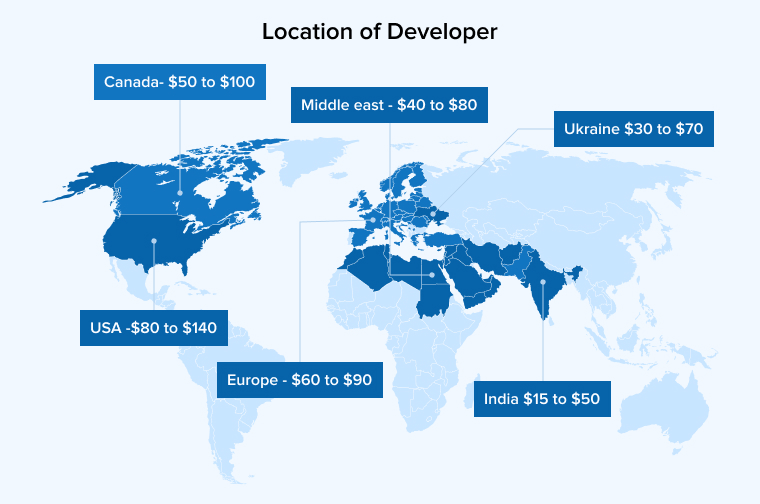
According to payscale.com, The compensation of Java developers varies across different geographies:
- In the United Kingdom, the annual income is reported to be £40,950.
- The annual income in the United States is $1,15,840.
- In Germany, the average annual income is €53338.
- In Canada, the average annual income is C$74,031.
The compensation for PHP developers exhibits variation across different geographical locations:
- The annual salary in the United Kingdom is £32,837.
- In the United States, the annual income is reported to be $68/927.
- In Germany, the average annual income is €49,508.
- In Canada, the average annual income is C$65,253.
1.6 Different Hiring Options
There are two possible approaches to consider when looking for dedicated developers to build web applications for you.

- In-house Development
The initial idea that comes to mind is certainly to hire a web developer. However, the financial burden associated with the recruiting, training, and retaining of an in-house developer is high.
Furthermore, regardless of the urgency of the job at hand, someone must make monthly payments to full-time engineers.
Companies with multiple divisions and the constant need for internal communication benefit greatly from in-house teams. However, this may not be the best option for you if you are just getting started with your company.
- Outsourced Development
The most efficient time-saving strategy of the decade is outsourcing. If you reside in a location where web application development services are excessively costly, consider hiring a dedicated developer from a nation where the cost of building websites is more reasonable. Furthermore, when you outsource, you’re collaborating with an entire team that can take your app from concept to completion.
Outsourcing can help you save a lot of money on salaries. The outsourcing firm’s hourly charges are applied solely to the actual job completed.
When you have an in-house team but lack many experts to meet your deadline, IT staff augmentation can help. If you decide to hire additional specialists to work in-house, you are free to do so at any scale. In this scenario, you’ll be paying an outsourcing firm for the time spent on your project by their experts.
When you outsource software development, from proposal to execution, the vendor retains ownership of the development approach while you retain ownership of the intellectual property.
1.7 Composition of Your Web App Development Team
Diverse web application development projects call for diverse skill sets on the part of the development team. The following individuals are often found on a team that is tasked with creating a web application:
- Business Analyst
A business analyst is an invaluable resource for conducting market research, identifying your target demographic, determining essential features, and much more. Do not underestimate the value of consulting with a seasoned business analyst, since doing so is likely to keep you away from making mistakes in your strategic planning.
- Designer
The aesthetic value of an app cannot be overstated. Hiring an experienced UI/UX designer is the surest way to increase sales.
- QA Engineer
A QA engineer’s role is to find any issues with the product during testing to ensure they are resolved before causing problems for customers.
- Software Developers
One competent programmer can manage both the front- and back-end implementations if JavaScript is used as the primary technology. But if you want to handle more complicated problems in less time and get your product to market faster, you need to hire more programmers.
- Project Manager
The project manager is responsible for assembling the team. A project manager’s primary responsibility is to ensure that all tasks are completed by their assigned deadlines, while also keeping you, the project stakeholder updated and informed. In a nutshell, hiring a project manager will take care of all of your problems and give you more time and energy to focus on developing your business plan.
Each circumstance is unique. Perhaps you already have a designer and a solid business strategy in place; all you need now is an expert in app development and testing. Maybe you’re just starting, but you’re dedicated to making a killer online app. In that situation, you should assemble a team consisting of the aforementioned experts.
1.8 3rd-Party Integration
The term “third-party software” refers to a software component that is provided or created by a different firm or individual other than the original developer of a certain product inside a given system. There is a wide range of kinds in which third-party solutions are available. The popular categories of third-party software are library resources, platforms, and tools.
The use of more integrations is directly correlated with an increase in total project cost. To satisfy the requirements of complex projects, it is crucial to include software developers who hold a sufficient level of technical proficiency. These experts are in charge of putting the proper third-party application programming interfaces (APIs) into place and making sure they work flawlessly.
Additional testing is necessary for third-party integrations. The use of skilled testers is essential for evaluating the application’s compliance and its interaction with the provider’s API. Additional expenses may emerge from the need for continuous and reliable maintenance following the deployment of technically complex APIs.
Without including the User Acceptance Testing (UAT) phase, the average time investment for integrating a third-party API is 8 to 24 hours. Depending on the extra steps and tasks that need to be completed, the price of the service might be anywhere from $200 to more than $800,.
1.9 Maintenance and Support
Website maintenance commonly involves many tasks, such as virus checks, software updates, content revisions, broken link fixes, and ongoing performance monitoring. We assign the specific responsibility based on its maintenance schedule.
The cost of maintaining a website can differ based on several aspects such as the complexity of the website and the specific services needed. The range of monthly costs is $500 to $5,000, while the range of annual rates is $5000 to $60,000.
2. Phase-wise Web Application Development Cost
Web application costs can vary significantly based on several factors, such as the complexity of the program, the size of the development team, and the location of the developer. Here is a comprehensive overview of the expenses related to every stage of web application development to assist you in obtaining a complete cost estimate:
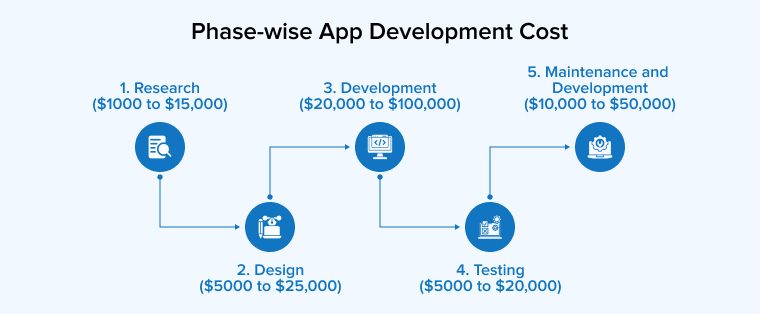
2.1 Research Phase
- The cost range for this phase spans from $1000 to $15,000.
- The estimated duration for completion is from two to eight weeks.
The research phase is essential for outlining the project’s requirements and scope and for discovering any risks and impediments. It lays the groundwork for the whole project and ensures that everyone engaged has a thorough grasp of the projected needs.
Research that requires a thorough analysis of potential, encompasses several stakeholders or displays a high level of complexity may lead to an increase in project expenditures.
2.2 Design
- The cost of this phase ranges from $4000 to $20,000.
- The estimated duration for completion is from three to eight weeks.
The development of a visually beautiful and logically developed user interface is important. Since it establishes the overall user experience, application design is an essential step in the process. At this point, the design includes layout, color palette, typography, and various other user interface elements.
The complexity of the design will determine how much it will cost to finish the design phase. A more intricate design will necessitate require more time and money to complete than one that is simpler. If a design undergoes multiple revisions, the cost and time required to finish it will probably increase.
2.3 Development
- The cost of this phase ranges from $20,000 to $100,000.
The primary focus is during the development phase, which involves implementing the web application’s code. Any development process consists of three components: database development, front end (client side), and back end (server-side). To create the features in the best possible way, this process might take a long time and include several changes, which can result in extra expenses.
2.4 Testing
- The cost of this phase ranges from $5000 to $20,000.
- Duration: Continual
The primary goal of the testing process, which is a crucial component of web development, is to ensure that the app functions as intended and is free of errors. The method consists of several parts, such as user acceptance, integration, and unit testing.
2.5 Maintenance and Support
- The annual cost ranges from $5,000 to $60,000.
- Duration: Continual
Maintenance is a continuous and ongoing process. The program’s core technology may become outdated as it gains popularity and usage. Thus, program maintenance includes debugging, code optimization, feature addition, and scalability enhancement.
The web application is incorporated into the production environment as part of the deployment process, and ongoing support and maintenance are given. The procedure has many steps, including server configuration, web application deployment, and setup of the production environment.
3. Tips to Reduce Web Application Development Cost
Without a cost-effective strategy, the process of developing a web app might end up costing quite a bit. The following suggestions should be considered if you want to maintain excellent standards while keeping costs down:
3.1 It is Necessary to Strategize the Fundamental Features
The development of web applications may lead to higher expenses if they incorporate more features. Therefore, it is crucial to clearly define and outline each feature during, the planning phase to prevent unexpected costs in the future.
Some suggestions for planning the core features of a web app are detailed below:
- The current objective is to determine who needs to see this and then to define what makes them tick so that we can meet their requests.
- During the process of selecting features, make sure you obtain input from important stakeholders.
- One might use the Must-have-should-have-could-have-and-won’t-need (MoSCoW) method to rank characteristics in order of importance.
Improving the user experience, shortening product launch times, giving an advantage in the market, increasing revenue, and decreasing development costs are all possible outcomes of implementing a thoughtful variety of features.
3.2 Develop a Minimum Viable Product
If we find a project’s components to be non-functional or if the end product doesn’t meet expectations, we could waste financial resources.
For complex projects especially, building a prototype is a beneficial strategy for reducing the likelihood of such problems. One possible cost-effective approach is to create a minimal viable product (MVP) with just the most essential features and minimal functionality. Use a focus group to assess the Minimum Viable Product (MVP), and then incorporate any necessary changes based on the feedback you get.
It is crucial to get user feedback throughout the MVP testing phase to improve the final product. Inquiries, surveys, usability tests, and statistics are some of the ways data may be collected.
There are several ways in which feedback significantly affects the final result:
- Finding and ranking the most important characteristics is the current job at hand.
- Optimize the user experience by making existing features more user-friendly.
- Figure out what’s wrong with the software or other technological issues that are lowering the quality of the user experience and fix them.
3.3 Utilize Third-party Platforms
It is often more advantageous to utilize an existing platform or technology from another company rather than developing a new solution from scratch. Numerous third-party libraries are at your disposal, each designed to do a certain task. When developing your app, one way to add mapping capabilities is by integrating Google Maps API from a third party. You might also consider adding a widely used ordering or messaging system. This approach can lead to cost savings in the long run.
4. Conclusion
Numerous factors that may affect web application development cost were discussed in this article. Your understanding of how businesses control and oversee project budgets is now comprehensive.
To support the growth of your business, TatvaSoft provides web application development services and the best solutions available.


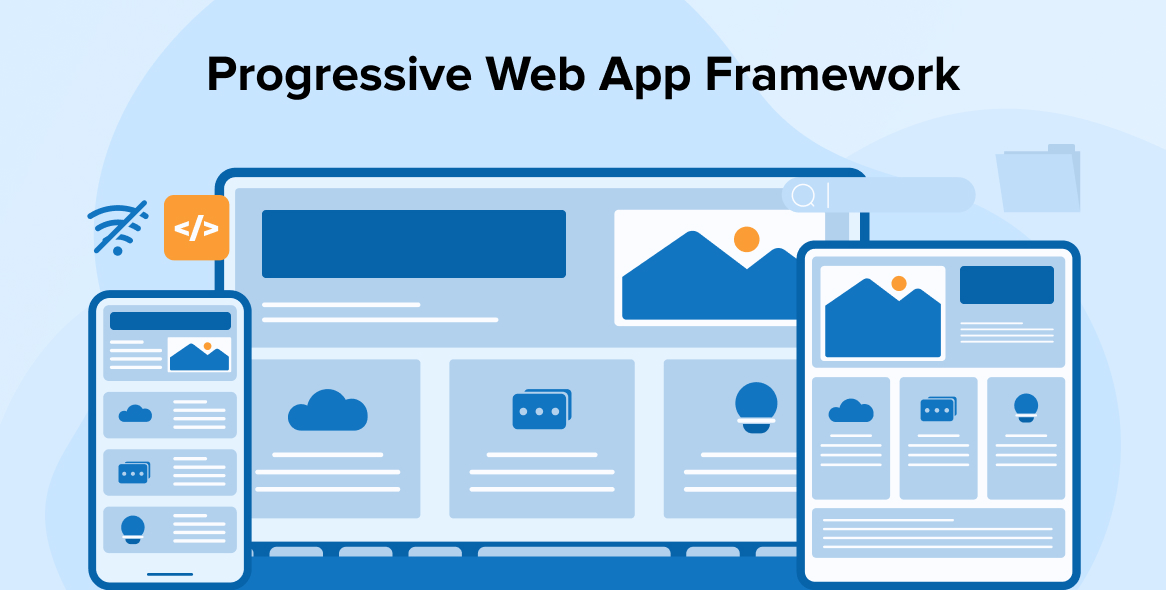
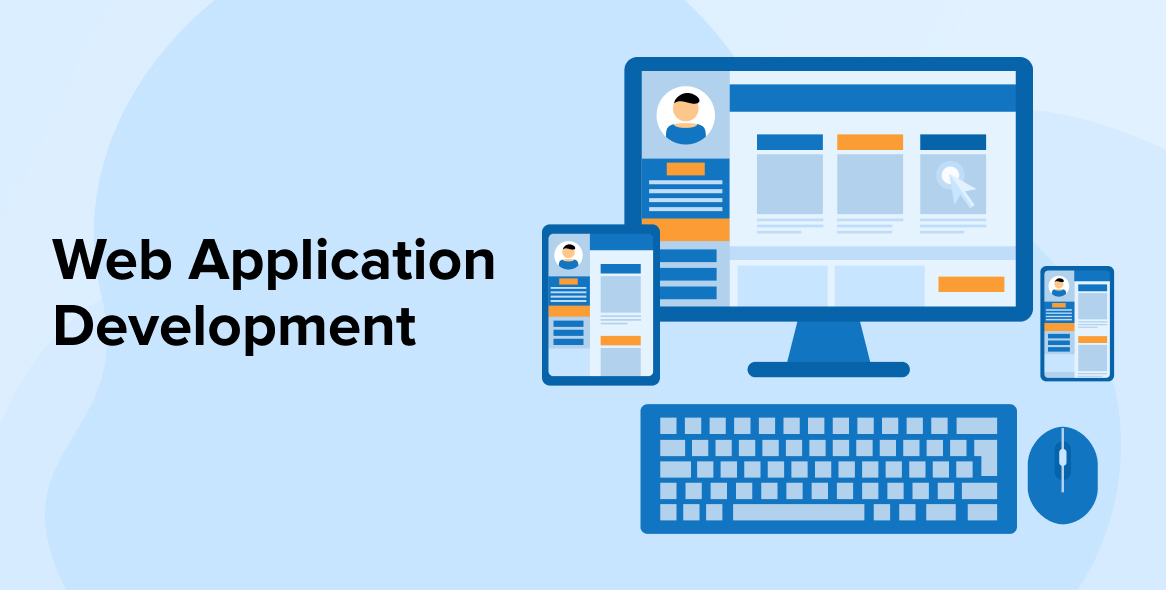
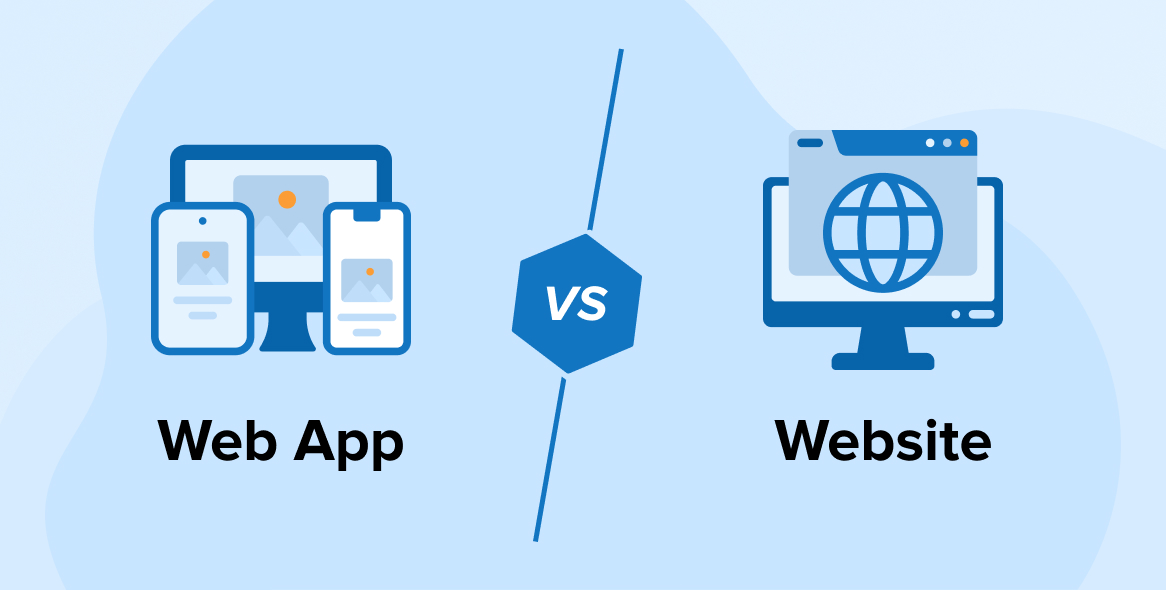

Comments
Leave a message...